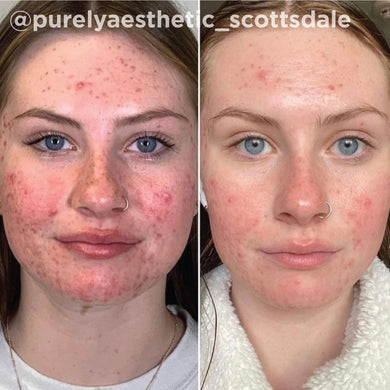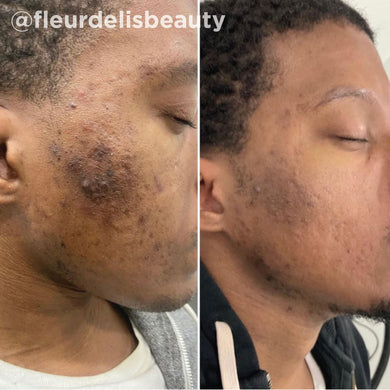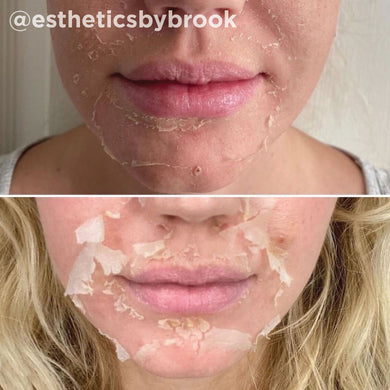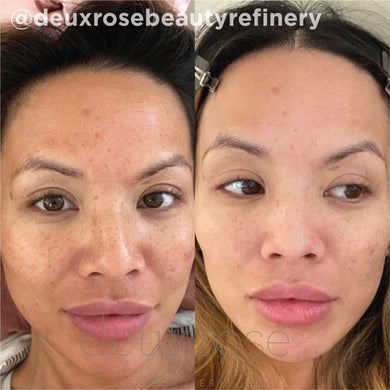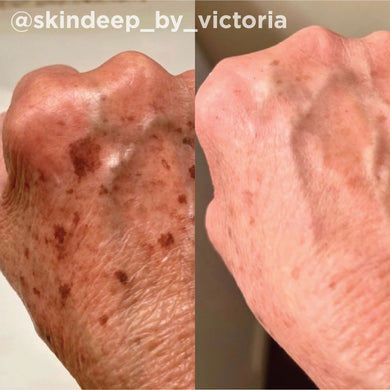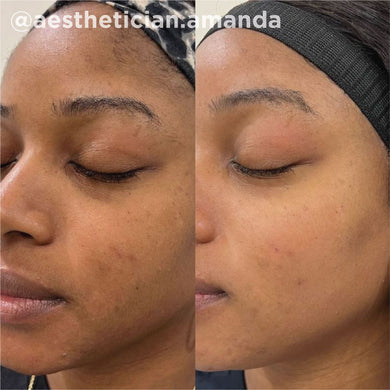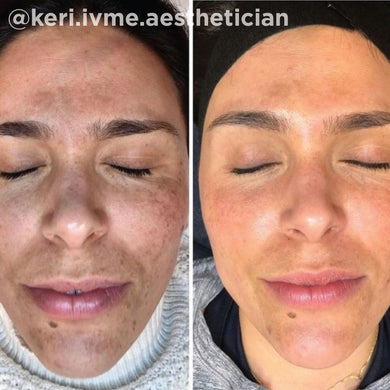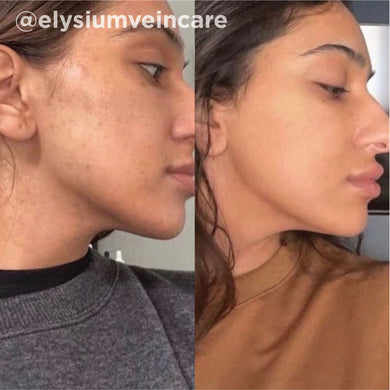Purging Post-Peel?
Professional chemical peels like VI Peels are designed to deliver smoother, more radiant, and clarified glowing skin. But before you get to the so-good benefits, you might undergo some side effects like skin purging—also known as the rapid rise of once-buried oil and debris in the form of bumps that resemble breakouts. Though the likelihood of skin purging is low with VI Peels, it can happen – and when it does, it is often short-lived and does not scar. Think of the skin purging process like purging your closet – we all dread doing it, but love seeing the end results. Read on to see why this process can be the precursor to your most beautiful post-peel skin ever.
First things first: don’t panic about post-peel purging skin
Once the dreaded side effect of skincare peel enthusiasts everywhere, science-backed education has helped purging skin emerge as a natural, normal process that we should embrace. It’s actually a good thing, helping your skin to remove impurities as quick as possible. So, what is skin purging?
Skin purging is the rapid rise of once-trapped oils and debris from deep within the skin to the surface, triggered by rapid exfoliation and cellular turnover. Peels with chemical acids like alpha hydroxy acids (glycolic acid) and beta hydroxy acids (salicylic acid) induce rapid exfoliation (also known as skin cell sloughing) that forces newer cells to the surface. Along with those cells comes oil and debris that was once trapped below the surface.
The rapid rise of oils and debris classified as skin purging ranges from a little clear bump and a pimple or two, to more intense blackheads, whiteheads, pustules, and flaking. Even some stronger topical prescription products, including at-home peels and the FDA-approved gold standard star of skincare, tretinoin (and its retinol derivatives), can trigger skin purging because it also expedites cell turnover that forces newer cells, oils, and debris to the surface.
Skin purging is often referred to as acne purging or identified as an acne purge, but this isn’t necessarily correct. While breakout-like conditions do show on the surface, acne is a chronic skin condition, whereas post-peel purging is a phase.
The good news: Once your skin transitions through purging after a chemical peel like the VI Peel, your skin will settle down, and you’ll see the smoothness, clarity, and radiance that originally piqued your interest in getting a professional peel.
So, Is that a post-peel pimple, or are you post-peel purging?
The difference between a pimple or acne and post-peel purging is hard to distinguish but is essential to monitoring your skin’s health and tolerance after a professional peel. Here are some things to look for when determining the difference between skin purging versus breakouts:
Purging after a chemical peel can:
- Start as soon as a few days after a peel
- Last as long as 10-14 days depending on your skin’s normal cell turnover and renewal time frame, and then never return (a typical phase only lasts a few days)
- Traditionally show in areas where you commonly breakout
- Clear quicker than a breakout
- Less likely to leave scarring than typical acne breakouts
Breakouts after a chemical peel can:
- Appear in all areas, including those where you don’t normally break out
- Can take longer to appear on the surface post-peel and take longer to clear
- Also be a side effect of a recommended post-peel product designed to soothe or protect
- Be less of a phase and more of a recurrence—or even a sign of irritation
It’s important to keep in touch with your dermatologist or skincare professional, especially if you’re experiencing skin concerns after your first chemical peel, as they can help diagnose the differences between purging and regular breakouts to set you on a path towards recovery.
Will a series of peels help mitigate skin purging?
Yes! A consistent skin care regimen coupled with a series of peels will regulate the skin and its purging process. Every skin type and skin concern are different. That’s why there’s no guarantee that each subsequent peel won’t induce some sort of purging. However, consistency with professional peels can help improve skin health and clarity—which should ultimately lessen, or completely eliminate, the purging process. With a VI Peel, we typically see improvement in skin purging after about 2-3 VI Peels, though each person is different. Try the VI Peel Purify for treating active acne - like cystic acne and adult acne - or the VI Peel Purify with Precision Plus for active acne and acne scarring.
If you’re genuinely concerned about experiencing purging after every peel, speak with your dermatologist or medical professional before undergoing a peel regimen. Though your post-peel purge shouldn’t last too long, with a max of around 10 days (again, depending on your normal skin cell turnover rate that is influenced by many factors including your natural age and overall skin health), your medical professional may have more recommendations, like spacing out the timing between your peels, and/or pre-introduce your skin to post-peel skincare products.
What can you do to help skin through post-peel purging?
- The number one rule of purging: keep your hands off your face. There should be absolutely no picking, poking, or popping. Peels naturally introduce what’s known as “controlled trauma” and your skin is healing from those effects. That means the last thing you need to do is introduce more insult to injury by picking at what’s surfaced. Leaving your skin alone can help speed up skin purging.
- Second only to the “hands off” rule is to be patient. Yes, you may experience some skin purging. But, the payoff is tighter, smoother, radiant, and healthier-looking skin—and that will last longer than any purge.
- Follow your dermatologist’s or medical professional’s post-skincare product and regimen advice to the letter. Don’t deviate from any prescribed or recommended skincare products or procedures without first speaking to your dermatologist.
- Don’t self-prescribe spot treatments to manage signs of purging, as many contain exfoliating ingredients that your skin doesn’t need during this stage. If you’re genuinely concerned, speak to your dermatologist and ask for a recommended spot treatment or procedure to help lessen purging bumps.
- Don’t dry out your skin. Remember, skin purging can also surface as dryness and flaking. Keep skin hydrated and protected from UV light with sunscreen, UV-protective clothing and wide-brimmed hats.
Lastly, it’s important to reiterate that the skin purging process is a completely safe, normal, and natural process for your skin to rid itself of impurities as quickly as it can. It shouldn’t last very long and should not leave any scars. Think of skin purging as a temporary “phase” that ultimately leads to improved skin health and longer lasting results. Happy Peeling!
